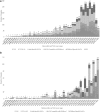Patterns, trends and methodological associations in the measurement and valuation of childhood health utilities
- PMID: 30783876
- PMCID: PMC6571090
- DOI: 10.1007/s11136-019-02121-z
Patterns, trends and methodological associations in the measurement and valuation of childhood health utilities
Abstract
Purpose: To systematically assess patterns and temporal changes in the measurement and valuation of childhood health utilities and associations between methodological factors.
Methods: Studies reporting childhood health utilities using direct or indirect valuation methods, published by June 2017, were identified through PubMed, Embase, Web of Science, PsycINFO, EconLit, CINAHL, Cochrane Library and PEDE. The following were explored: patterns in tariff application; linear trends in numbers of studies/samples and paediatric cost-utility analyses (CUAs) and associations between them; changes in proportions of studies/samples within characteristic-based categories over pre-specified periods; impact of National Institute for Health and Care Excellence (NICE) guidance on primary UK research and associations between valuation method, age and methodological factors.
Results: 335 studies with 3974 samples covering all ICD-10 chapters, 23 valuation methods, 12 respondent types and 42 countries were identified by systematic review. 34.0% of samples using indirect methods compatible with childhood applied childhood-derived tariffs. There was no association between numbers of studies/samples and numbers of CUAs. Compared to 1990-2008, 2009-June 2017 saw a significant fall in the proportion of studies using case series; significant compositional changes across ICD-10 chapters and significantly higher sample proportions using childhood-specific and adult-specific indirect valuation methods, and based on pre-adolescents, self-assessment, self-administration and experienced health states. NICE guidance was weakly effective in promoting reference methods. Associations between valuation method, age and methodological factors were significant.
Conclusion: 1990-2017 witnessed significant changes in primary research on childhood health utilities. Health technology assessment agencies should note the equivocal effect of methodological guidance on primary research.
Keywords: Childhood health states; Cost–utility analysis; Economic evaluation; Health utility; PRISMA; Systematic review.
Conflict of interest statement
Mr Joseph Kwon, Dr Sungwook Kim, Dr Wendy J. Ungar, Ms Kate Tsiplova, Dr Jason Madan and Dr Stavros Petrou declares that they have no conflict of interest.
Figures



References
-
- Drummond MF, Sculpher MJ, Claxton K, Stoddart GL, Torrance GW. Methods for the economic evaluation of health care programmes. Oxford: Oxford University Press; 2015.
-
- NICE (2013). Guide to the methods of technology appraisal 2013. - PubMed
-
- SMC (2017). Working with SMC—A guide for manufacturers.
-
- CADTH (2017). Guidelines for the economic evaluation of health technologies: Canada 4th Edition.
-
- PBAC (2015). Guidelines for preparing submissions to the Pharmaceutical Benefits Advisory Committee (Version 4.5).
Publication types
MeSH terms
LinkOut - more resources
Full Text Sources
Molecular Biology Databases

